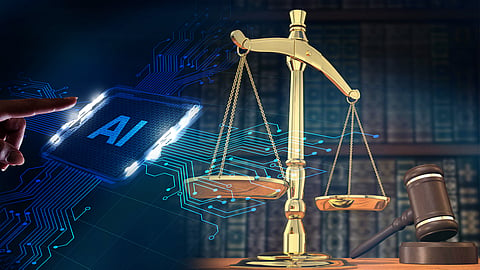
- Latest Legal News
- News
- Dealstreet
- Viewpoint
- Columns
- Interviews
- Law School
- Legal Jobs
- हिंदी
- ಕನ್ನಡ

A machine that can write code, discover chemical compounds, design aircraft parts and even draft patent claims - this isn't science fiction anymore. Artificial Intelligence (AI), once a passive assistant, is now inching towards the role of active innovator.
But as machines start doing what humans have historically been celebrated and rewarded for, a pressing legal question arises: if AI is inventing, who is the inventor? And more specifically, can its inventions truly be called "novel"?
At the heart of patent law lies the concept of novelty, that an invention must be new, not known to the world before. The Indian Patents Act, 1970, under Section 2(1)(j), defines an invention as a new product or process involving an inventive step and capable of industrial use. Furthermore, Section 13 empowers the patent office to determine whether the claimed invention is anticipated by prior art or public disclosure. The entire regime, both in text and spirit, is built around a human innovator - someone who conceives an idea that did not previously exist and takes intellectual ownership of it.
But AI, by its very design, defies that structure. As Axel Schwanke observes in his reflection on AI and creativity, today’s generative models are capable of producing outputs that appear thoughtful, useful, and at times, even ingenious. But beneath the surface, their process is fundamentally different from that of a human creator. These systems operate by drawing from immense volumes of existing material, identifying patterns and recombining them in new ways. They don’t truly grasp the context or emotional weight of what they generate. Schwanke emphasises that while their results may seem novel, what’s missing is the personal experience, intuition and depth of understanding that typically accompany human expression.
Yet, this distinction is becoming harder to defend in practice. AI systems like AlphaFold have made scientific discoveries, such as predicting the structure of proteins with such speed and accuracy that they arguably outperform human researchers. If their output leads to real-world applications, cures or technologies, should they be denied recognition under the patent system merely because no human truly conceived the idea? This is no longer a theoretical dilemma.
Globally, the debate has already reached courtrooms. In the DABUS litigation, patent applications were filed in multiple jurisdictions listing an AI as the sole inventor. Most patent offices, including those in the US, UK and EU rejected the applications, reiterating that inventorship must reside with a natural person. The assumption is simple: only a human can invent. But the assumption may not be future-proof.
India is now stepping into the legal conversation around AI and intellectual property. In an ongoing case before the Delhi High Court, some of the country’s largest media houses, including the Indian Express Group, Hindustan Times, NDTV and the Digital News Publishers Association, have challenged OpenAI, alleging that it used their news content without consent. While the core issue is copyright infringement, the case raises larger questions about how generative AI systems engage with existing IP laws. If AI models can absorb, reframe and reproduce proprietary content at scale, what happens to the traditional boundaries of ownership, attribution and originality?
These questions acquire sharper teeth when applied to patent law. Consider that AI models today can generate hundreds of variations of a known invention, say, a new blade design or drug formulation, each marginally different from the last. On paper, they may clear the novelty hurdle. But in essence, they remain statistical derivatives of existing knowledge. The current novelty test, rooted in static databases and human literature searches, may be unfit for a world where machines can pre-empt prior art at machine speed.
WIPO's report by Lukas Gonçalves highlights this problem in no uncertain terms. When AI starts going beyond its training and producing content that bears signs of originality and autonomy, we're no longer dealing with traditional authorship or inventorship. Even if a human initiates the process, the outcome may be something no human foresaw. Should this be protected? If yes, who owns it? The developer? The user? Or no one at all?
In India, the answer is likely to be cautious, at least initially. Our courts have historically favoured public interest and substantive merit over technicality. The Supreme Court's decision in Novartis AG v. Union of India is a striking example. There, despite the patented compound being structurally distinct, the Court refused protection because it did not demonstrate enhanced efficacy. Substance over form has always been the guiding principle.
This cautious, evaluative approach may serve us well in navigating the grey area of AI-assisted inventions. Rather than rushing to declare all machine-generated outputs patentable or unpatentable, India could explore an intermediate framework. One where human involvement, control and intent are weighted heavily in determining inventorship. One where AI is not the inventor, but a tool whose contributions are acknowledged and scrutinised.
The road ahead is complex, but not impassable. Some have suggested the creation of a sui generis category for AI-assisted inventions. Others propose expanding the definition of inventorship to include human-AI collaboration, provided there is transparent disclosure. Whatever the approach, the time to begin is now. Because while the law still debates whether AI can invent, AI is already doing it.
Novelty, like creativity, is no longer a uniquely human trait. The statute may still expect a spark of human genius, but machines are now generating sparks of their own. As they do, the law must evolve. It does not need to rewrite the definition of novelty overnight. But it must begin to interpret it for a world where invention is no longer just about imagination.
And perhaps, as machines learn to invent, the law must learn to imagine.
Nandita Goyal is a practicing advocate and marketing executive based out of Surat.
Views and opinions expressed are personal.